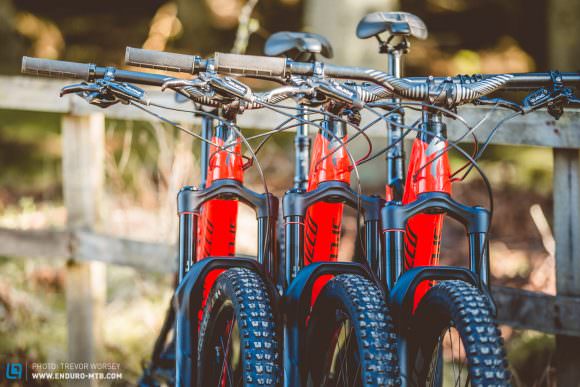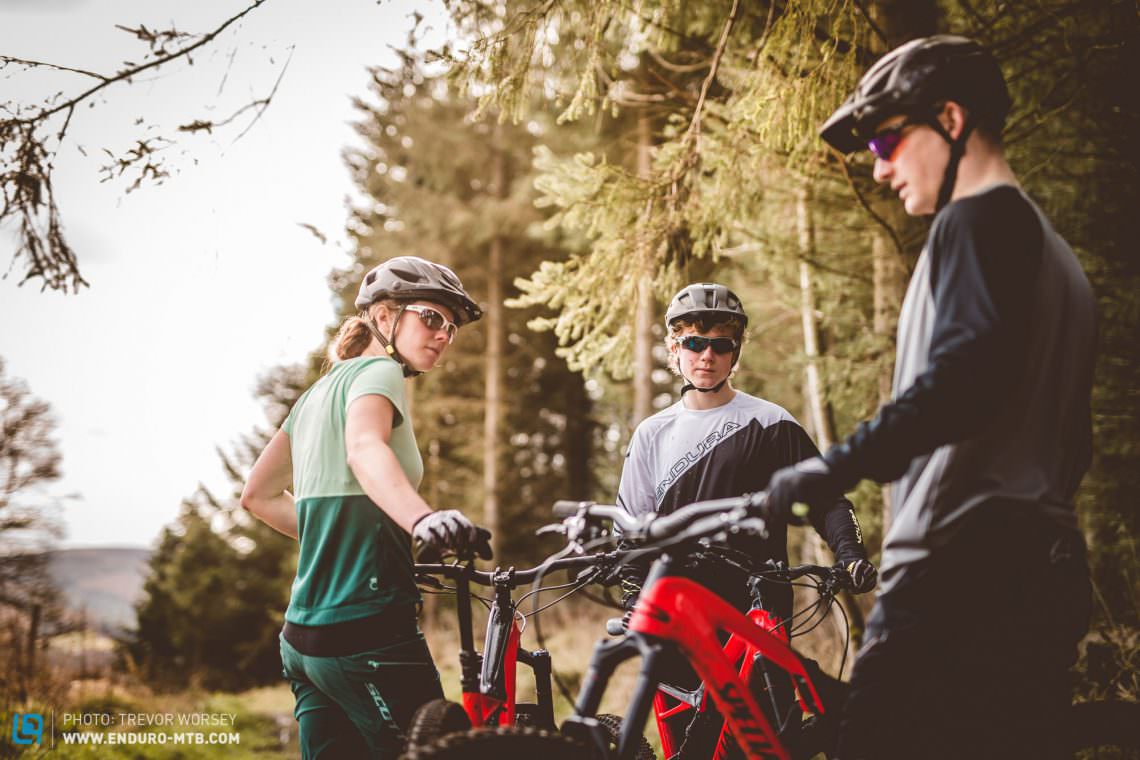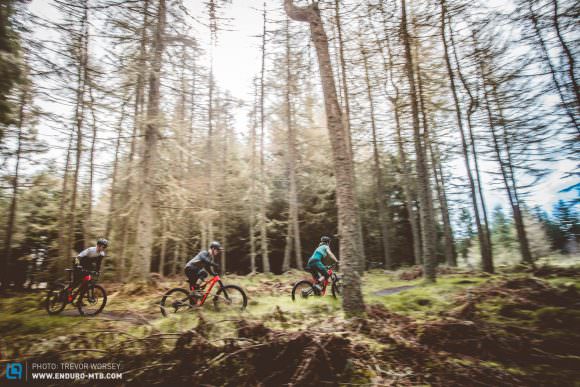There is nothing worse than being stuck in the middle, to be an inbetweener, neither one nor the other. We’ve all been there… after the seemingly endless decision on which new bike to buy, we finally make our choice. Decisions made, website loaded, and mouse hovering over the BUY NOW button, we freeze. What size? Shit.
Let’s face it, bike sizing is all over the place at the moment. Our bikes are changing: some brands are stretching and supersizing everything, while others are sitting on the fence. Looking at the data from thirty leading enduro bikes, all size large, there’s a 7.8 cm difference in reach from the shortest to the longest and a whopping 14.6 cm in wheelbase – huge differences in a world of minutia. A size Small, yes Small, Whyte G-160 or Mondraker Dune is longer in reach and wheelbase than a size Large Specialized Enduro. It’s just madness! Some riders are so intimidated by the new geometry they are choosing a size smaller than recommended, but is that what the designers intended? Of course not. With so much variety, now more than ever, we are reliant on manufacturer guidelines to tell us what size we need.

The curse of the inbetweener
For most of us the choice is easy, dropping neatly into a size bracket. But what about those who find themselves bordering two sizes on the recommendation chart? We are cursed as an inbetweener, stranded in indecision. We wouldn’t buy shoes that are a size too small or large, so the last thing we want to do is spend a four figure sum on a bike that’s the wrong size. To make matters worse, it’s only when you find yourself on the border between two sizes that you find each of your friends is suddenly an expert in bike geometry: “Go bigger, you don’t want a BMX,” or “Don’t go bigger, or it will be as agile as pushing a cow up a staircase!” It’s a minefield.
The first and most important advice is “Don’t panic.” If you’re an inbetweener, straddling two sizes, then the manufacturer is confident both sizes will work just fine with a little customisation – but that doesn’t really answer the question, does it? Over the last few months, we have gathered together a number of inbetweeners and exposed them to identical bikes in Medium, Large, and Extra Large sizes to see how differently they ride. We chose to use the ‘godfather’ of trail bikes, a Specialized Stumpjumper, now considered quite conservative when it comes to sizing (but with a heritage that is unquestioned). With identical tires, suspension setup, and contact points the only difference is the sizing.


It’s not the size that counts, it’s what you do with it?
So what actually changes when we move through the sizes? Of course, this is something that varies wildly from brand to brand, but, if we take the Specialized Stumpjumper as an example, jumping from a Large to an Extra-large, what are the actual differences? Most of the changes are small: a 22 mm difference in reach, another 9 mm on the stack, just 10 mm on the head tube length, and 26 mm on the wheelbase – hardly a giant leap. The only really significant change is the extra 55 mm on the seat tube that allows the seatpost to be run higher. While the Stumpjumper certainly does not have an extreme geometry, when it comes to hard numbers most brands do not differ that much between sizes, averaging around 20 mm in reach from size to size and 50 mm on the height of the seat tube.

How does body shape affect size choice?
Most modern bikes now have very low standover heights, allowing a greater number of riders to fit on a broader range of sizes. Still, we’re all made differently. Some of us have legs like hobbits, while others resemble lanky flamingoes in riding shorts. The first thing to do when comparing sizes is to see if you will have enough room for proper seatpost extension. Measure the length of your current bike’s seatpost from BB to seat clamp, then compare it to the length of the two size options. If the larger of the two options is much longer than your current bike, you will either have to fit a lower travel dropper or the bike will be too big. Remember, if you want to run a longer dropper you will need even more space. Inversely, if you have the proportions of a giraffe, you may look to size up to be sure you will have enough seat tube height to provide the minimum insertion depth for your dropper post.


What kind of Ape are you?
OK, so both sizes will fit your desired dropper post – now what? What about the reach? First, measure your height with a tape measure, then measure your arm span from fingertip to fingertip. Subtract your arm measurement from your height, and the resulting number is your Ape index. If you are left with a negative number, you have longer arms than average and as such, may prefer a bike with longer reach – assuming the seat post fits. If you are left with a positive number, your arms are shorter than average, so you may prefer a bike with a shorter reach. While this is not a definitive answer, it gives you a better understanding of what may work for you. Remember, reach does not take into account seat angle. If your proposed new bike has a steeper seat tube than your current bike (which is a good thing), the seat will be closer to the bars and it will feel more compact even though the reach numbers are the same.

I’m stuck in the middle… will I make a mistake?
It’s rare to jump on any bike and for it to instantly fit. Luckily, we have lots of control over how we interact with our rides. We can fit a shorter or longer stem, move the seat forwards and backwards on its rails, and even adjust the reach and height of the bars with spacers or by fitting a riser (or flat) bar. If we fall between sizes, the manufacturer is confident that either of the two options should be able to be tailored for a good fit using the above alterations – but again, we still have not answered the question.
So what’s the answer?
You’re in inbetweener, faced with one model and two size choices. Using the above tests, both fit. So, which is the right bike for you? We took inbetweeners of all levels, from beginner to elite racer, to the trails with three identical bikes in different sizes. Contrary to the “bigger is better mantra” of the industry, while many riders chose the larger of the two sizes, there were some riders who preferred to size down – why?


SIZING DOWN
Looking at the feedback sheets of testers who sized down, it was easy to see a clear trend. These were the riders who had a playful style, who loved to pop manuals and ride tight and technical trails. When compared, sizing down scored highly on our test sheets for agility and playfulness. The smaller bikes were more chuckable, easier to throw into tight turns, and encouraged a playful and active riding style: “I really like how nimble the smaller of the two sizes is, so easy to cut through the turns and throw around. Perfect for my playful style.” The smaller size was the bike of choice for riders who enjoy airtime, ride predominantly in tight and twisty terrain, or place a high value on playing with the trail.

SIZING UP
Sizing up was the popular choice for riders who live for high speeds, looking for a stable and confident ride. This was the choice of the KOM hunters, or those who prefer ground combat over aerial dogfighting. Long-legged riders enjoyed the taller seat mast, providing more options when it comes to seatpost height. Sizing up gave a longer wheelbase that is more stable at higher speeds, and the spacious cockpit offered more comfort on long climbs: “For me, I like the longer wheelbase of the XL compared to the L, and the increased reach, as the bike is more comfortable on long days out on the pedals.” Sizing up is a good option for those with long legs, or riders who value high speed and stability over snappy cornering.


Conclusion
Ultimately, we cannot give an absolute answer, but we hope we have given you some useful tools to escape the curse of the inbetweener. If you find yourself straddling two bike sizes, nothing beats a test ride of the options. If that’s not possible, check out your own bike and those of your friends. What do you like, and what do you dislike? Think about your body shape and be honest with your riding style. It’s tough being an inbetweener, but there is a bike out there for everyone.
Did you enjoy this article? If so, we would be stoked if you decide to support us with a monthly contribution. By becoming a supporter of ENDURO, you will help secure a sustainable future for high-quality mountain bike journalism. Click here to learn more.
Words & Photos:









